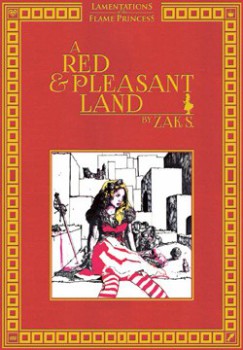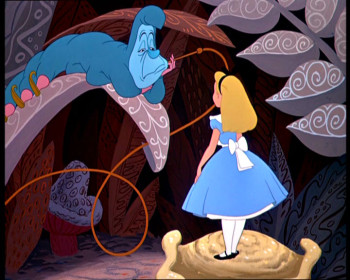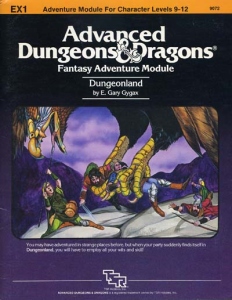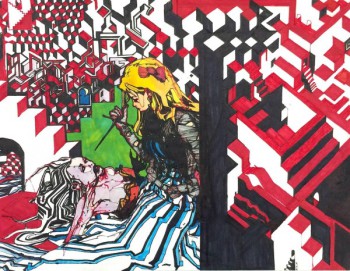A Red & Pleasant Land
 When I started school in the mid-1970s, our teachers used the New Macmillan Reading Program. The books in that program, in addition to featuring original stories, also included excerpts from world literature. I credit those readers with instilling in me a lifelong love of reading; to this day, I still remember many of the stories I read within their pages. In the seventh grade – this would have been 1981 or ’82 – one reader included a lengthy excerpt from Lewis Carroll’s 1871 novel, Through the Looking-Glass and What Alice Found There.
When I started school in the mid-1970s, our teachers used the New Macmillan Reading Program. The books in that program, in addition to featuring original stories, also included excerpts from world literature. I credit those readers with instilling in me a lifelong love of reading; to this day, I still remember many of the stories I read within their pages. In the seventh grade – this would have been 1981 or ’82 – one reader included a lengthy excerpt from Lewis Carroll’s 1871 novel, Through the Looking-Glass and What Alice Found There.
The excerpt in question dealt with Alice’s encounter with Humpty Dumpty, in which the anthropomorphic egg boasts that “When I use a word … it means just what I choose it to mean—neither more nor less.” He illustrated his point by quoting from the nonsense poem Jabberwocky. I can’t begin to tell you how profoundly I was impressed with and affected by this excerpt. Humpty Dumpty’s perspective was (and is) abhorrent to me and, along with Alice, I found myself feeling anger at his articulation of it. Despite that, I eventually memorized the whole of Jabberwocky (which I can still recite to this day) and headed to the library to read the whole book, as well as its predecessor, Alice’s Adventures in Wonderland.
I should clarify that, before this point, I was, of course, already broadly familiar with Wonderland and its denizens. Some of that familiarity was achieved via “cultural osmosis” – the same way I “knew” about, say, Davy Crockett or the Headless Horseman. These were things “everyone” knew about, regardless of whether or not they’d ever actually read a book (or even seen a TV show or movie) on the subject. And, as it happened, I had seen Disney’s 1951 film adaptation, inadequate though it was.
Seventh grade also coincided with the high water mark of the early years of my involvement in the roleplaying hobby. By that point, I’d been playing Dungeons & Dragons and other RPGs for a couple of years. My friends and I considered ourselves “veterans” and prided ourselves on how many different games we’d tried. I was also deep into the idolization of Gary Gygax. I hung on the man’s every word in the pages of Dragon magazine (though, to my credit, I never got around to building a literal shrine to him in my basement). It was probably through one of Gary’s articles that I first encountered the idea of combining D&D and Wonderland, an idea that initially struck me as bizarre, but that slowly grew on me as my love for both Carroll and RPGs did. Besides, I reasoned, if such a pairing was good enough for Gygax’s fabled Greyhawk campaign, who was I to think otherwise?
 Consequently, when it was announced some years(?) ago that Zak S. of the thought provoking old school/DIY blog Playing D&D with Pornstars was working on his own mash-up of Wonderland and D&D-style fantasy, my interest was piqued. I had had a lot of fun in the ’80s refereeing Gygax’s two Wonderland-inspired adventure modules, Dungeonland and The Land Beyond the Magic Mirror. The thought of being able to do something similar in the 21st century appealed to me greatly, especially after having thoroughly enjoyed Zak’s previously published RPG work. Furthermore, the book was to be released through Lamentations of the Flame Princess, whose products are always “different” from the usual fantasy fare, both in terms of content and – especially – presentation.
Consequently, when it was announced some years(?) ago that Zak S. of the thought provoking old school/DIY blog Playing D&D with Pornstars was working on his own mash-up of Wonderland and D&D-style fantasy, my interest was piqued. I had had a lot of fun in the ’80s refereeing Gygax’s two Wonderland-inspired adventure modules, Dungeonland and The Land Beyond the Magic Mirror. The thought of being able to do something similar in the 21st century appealed to me greatly, especially after having thoroughly enjoyed Zak’s previously published RPG work. Furthermore, the book was to be released through Lamentations of the Flame Princess, whose products are always “different” from the usual fantasy fare, both in terms of content and – especially – presentation.
What we got was A Red & Pleasant Land (hereafter AR&PL), a 192-page full color hardcover volume that wasn’t quite what I was expecting – and I mean that in a good way. Whereas other designers might have been content to follow in Gygax’s venerable footsteps and simply translate Wonderland and its inhabitants into D&D terms (i.e. reducing them to monsters), Zak S. has taken a different tack. He has chosen to use Carroll’s ideas as inspiration in the creation of a largely new setting, which he calls Voivodja or The Place of Unreason. As the first name suggests, Carroll’s novels aren’t the book’s only inspiration. AR&PL also borrows heavily from Eastern European legendry, re-imagining the Red King and the Queen of Hearts as vampires. Indeed, one might sum up AR&PL’s central premise as “Dracula vs. Elizabeth Báthory in Wonderland,” even if that summation doesn’t quite do justice to the depth and diversity of the setting.
 Voivodja is presented as what I recall the fine fellows at TSR calling a “capstone setting.” That is, Voivodja is usable both as a setting in its own right and as an adjunct to an existing setting: a weird place to visit as a change of pace from the usual dungeon delving. In this respect, it’s not unlike Gygax’s Dungeonland, even if it is wildly different in tone and presentation. AR&PL thus assumes that most adventurers are “foreigners,” going so far as to include a new character class – the Alice – that, obviously, looks to Carroll’s young protagonist as its model. Members of this new class are “actively sought by adventure,” which is why its description includes an “exasperation table” that is rolled once per game hour to generate all the queer and wonderful things (e.g. a secret door opening up nearby, something normally unable to speak begins to do so) that appear in the wake of an Alice’s explorations. I haven’t yet had the chance to use this class in play, but I look forward to doing so, as it looks like a lot of fun.
Voivodja is presented as what I recall the fine fellows at TSR calling a “capstone setting.” That is, Voivodja is usable both as a setting in its own right and as an adjunct to an existing setting: a weird place to visit as a change of pace from the usual dungeon delving. In this respect, it’s not unlike Gygax’s Dungeonland, even if it is wildly different in tone and presentation. AR&PL thus assumes that most adventurers are “foreigners,” going so far as to include a new character class – the Alice – that, obviously, looks to Carroll’s young protagonist as its model. Members of this new class are “actively sought by adventure,” which is why its description includes an “exasperation table” that is rolled once per game hour to generate all the queer and wonderful things (e.g. a secret door opening up nearby, something normally unable to speak begins to do so) that appear in the wake of an Alice’s explorations. I haven’t yet had the chance to use this class in play, but I look forward to doing so, as it looks like a lot of fun.
AR&PL adopts a two-pronged approach to presenting its setting. The first prong is focused on describing the inhabitants of Voivodja, from vampire rulers right down to unusual animals. In many cases, inhabitants are detailed not merely in terms of their game statistics, but in terms of their relationships. Thus, we learn about the schemes of the Red Brides, the unreliability of the Hatter, and the strange pity exhibited by the Duchess. Many of these details are short but piquant, providing just enough information to spur one’s own ideas. The second prong looks to adventure locations, like the Card Castle and the Looking Glass Palace, both of which might rightly be called “dungeons,” though neither is like any dungeon I’ve ever seen. Together, these two prongs describe the setting in enough detail to get a referee going while also offering him plenty of hooks, inspiration, and pushes in the right direction to encourage him to make it his own.
 My favorite section of AR&PL is the over 30 pages of random tables included at the end of the book. These tables run the gamut from random encounters and events to “idiotic Voivodja filibuster conversation openers” to “I search the body …” and more. What’s so enjoyable about these tables is how useful they are. They’re not just fluff intended to fill out a page count but rather a vital part of the setting presentation – which only makes sense given the phantasmagorical nature of The Land of Unreason (and Wonderland). If you’re the sort of person who dislikes random tables on principle, I’d hazard a guess it’s because you’ve only ever seen badly implemented random tables. I dare anyone to roll on the “intercepted communiqué” table and not be inspired by it, even you’re not planning to referee an adventure or campaign in Voivodja. It’s a real testament to their design that these tables are capable of a lot of heavy lifting at the table, making them perfect for referees like me who prefer to run much of their campaigns on the fly rather than relying on exhaustively keyed locales and NPC write-ups.
My favorite section of AR&PL is the over 30 pages of random tables included at the end of the book. These tables run the gamut from random encounters and events to “idiotic Voivodja filibuster conversation openers” to “I search the body …” and more. What’s so enjoyable about these tables is how useful they are. They’re not just fluff intended to fill out a page count but rather a vital part of the setting presentation – which only makes sense given the phantasmagorical nature of The Land of Unreason (and Wonderland). If you’re the sort of person who dislikes random tables on principle, I’d hazard a guess it’s because you’ve only ever seen badly implemented random tables. I dare anyone to roll on the “intercepted communiqué” table and not be inspired by it, even you’re not planning to referee an adventure or campaign in Voivodja. It’s a real testament to their design that these tables are capable of a lot of heavy lifting at the table, making them perfect for referees like me who prefer to run much of their campaigns on the fly rather than relying on exhaustively keyed locales and NPC write-ups.
A brief note about the appearance of AR&PL. This is probably one of the most attractive and evocative RPG books I’ve ever seen. From Zak’s own ink work (including some extraordinary maps) to the layout and overall graphic design, this is a gorgeous volume. It’s all the more remarkable in my opinion, because it was produced by a one-man operation rather than a subsidiary of an international multi-billion dollar toy company. For my money, AR&PL sets a new standard for what a roleplaying game book can look like. Mind you, Lamentations of the Flame Princess has a reputation for producing beautiful books, but, even so, this particular book stands head and shoulders above all the rest.
In a year that saw the release of yet another edition of Dungeons & Dragons, A Red & Pleasant Land is nevertheless the most impressive – and inspiring – RPG book to have come out in 2014. It’s wittily written, beautifully appointed, and, above all, bold in the way it reworks its source material to create something at once recognizable and original. Even if you’re not the least bit interested in adventuring in Wonderland, consider taking a look at A Red & Pleasant Land simply as an artifact. It’s a reminder of just how much energy and creativity is to be found in the old school/DIY gaming scene these days. Head over to the Lamentations of the Flame Princess store and grab a copy.
[…] A Red & Pleasant Land […]